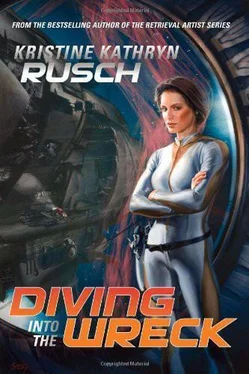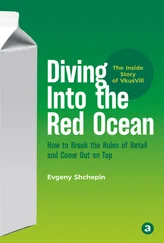“Huge, old.” Turtle shakes her head. “Dangerous. You know what’s inside?”
“Nothing, for all I know.”
“Didn’t check it out first?”
Some dive team leaders head into a wreck the moment they find one. Anyone working salvage knows it’s not worth your time to come back to a place that’s been plundered before.
“No.” I pick a spot not far from the main doors and set the skip to hold position with the monster wreck. With no trail, I hoped no one was gonna notice the tiny energy emanation the skip gives off.
“Too dangerous?” Turtle asks. “That why you didn’t go in?”
“I have no idea if it’s dangerous.” I’m referring to the skip, not diving alone.
Diving alone is always dangerous.
“There’s a reason you brought us here.” She sounds annoyed. “You gonna share it?”
I shake my head. “Not yet. I just want to see what you find.”
She glares, but the look has no teeth. She knows my methods and even approves of them sometimes. And she should know that I’m not good enough to dive alone.
She peels off her clothes—no modesty in this woman—and slides on her suit. The suit adheres to her like it’s a part of her. She wraps five extra breathers around her hips—just-in-case emergency stuff, barely enough to get her out if her suit’s internal oxygen system fails. Her suit is minimal—it has no backup for environmental protection. If her primary and secondary units fail, she’s a little block of ice in a matter of seconds.
She likes the risk; Karl doesn’t. His suit is bulkier, not as form-fitting, but it has external environmental backups. He has had environmental failures and has barely survived them. I’ve heard that lecture half a dozen times. So has Turtle, even though she always ignores it.
He doesn’t go naked under the suit either, leaving some clothes in case he has to peel quickly. Different divers, different situations. He only carries two extra breathers, both so small that they fit on his hips without expanding his width. He uses the extra loops for weapons, mostly lasers, although he’s got that knife stashed somewhere in all that preparedness.
They don’t put on the headpieces until I give them the plan. One hour only: twenty minutes to get in, twenty minutes to explore, twenty minutes to return. Work the buddy system. We just want an idea of what’s in there.
One hour gives them enough time on their breathers for some margin of error. One hour also prevents them from getting too involved in the dive and forgetting the time.
They have to stay on schedule.
They get the drill. They’ve done it before, with me anyway. I have no idea how other team leaders run their ships. I have strict rules about everything, and expect my teams to follow.
Headpieces on—Turtle’s is as thin as her face, tight enough to make her look like some kind of cybernetic human. Karl goes for the full protection— seven layers, each with a different function; double night vision, extra cameras on all sides; computerized monitors layered throughout the external cover. He gives me the handheld, which records everything he sees. It’s not as good as the camera eye view they’ll bring back, but at least it’ll let me know my team is still alive.
Not that I can do anything if they’re in trouble. My job is to stay in the skip. Theirs is to come back to it in one piece.
They move through the airlock—Turtle bouncing around like she always does, Karl moving with caution—and then wait the required two minutes. The suits adjust, then Turtle presses the hatch, and Karl sends the lead to the other ship.
We don’t tether exactly, but we run a line from one point of entry to the other. It’s cautionary. A lot of divers get wreck blindness—hit the wrong button, expose themselves to too much light, look directly into a laser, or the suit malfunctions in ways I don’t even want to discuss—and they need the tactical hold to get back to safety.
I don’t deal with wreck blindness either, but Squishy does. She knows eyes, and can replace a lens in less than fifteen minutes. She’s saved more than one of my crew in the intervening years. And after overseeing the first repair—the one in which she got her nickname—I don’t watch.
Turtle heads out first, followed by Karl. They look vulnerable out there, small shapes against the blackness. They follow the guideline, one hand resting lightly on it as they propel themselves toward the wreck.
This is the easy part: should they let go or miss by a few meters, they use tiny air chips in the hands and feet of their suits to push them in the right direction. The suits have even more chips than that. Should the diver get too far away from the wreck, they can use little propellants installed throughout their suits.
I haven’t lost a diver going or coming from a wreck.
It’s inside that matters.
My hands are slick with sweat. I nearly drop the handheld. It’s not providing much at the moment—just the echo of Karl’s breathing, punctuated by an occasional “fuck” as he bumps something or moves slightly off-line.
I don’t look at the images he’s sending back either. I know what they are—the gloved hand on the lead, the vastness beyond, the bits of the wreck in the distance.
Instead, I walk back to the cockpit, sink into my chair, and turn all monitors on full. I have cameras on both of them and readouts running on another monitor watching their heart and breathing patterns. I plug the handheld into one small screen, but I don’t watch it until Karl approaches the wreck.
The main door is scored and dented. Actual rivets still remain on one side. I haven’t worked a ship old enough for rivets; I’ve only seen them in museums and histories. I stare at the bad image Karl’s sending back, entranced. How have those tiny metal pieces remained after centuries? For the first time, I wish I’m out there myself. I want to run the thin edge of my glove against the metal surface.
Karl does just that, but he doesn’t seem interested in the rivets. His fingers search for a door release, something that will open the thing easily.
After centuries, I doubt there is any easy here. Finally, Turtle pings him.
“Got something over here,” she says.
She’s on the far side of the wreck from me, working a section I hadn’t examined that closely. Karl keeps his hands on the wreck itself, sidewalking toward her.
My breath catches. This is the part I hate: the beginning of the actual dive, the place where the trouble starts.
Most wrecks are filled with space, inside and out, but a few still maintain their original environments, and then it gets really dicey—extreme heat or a gaseous atmosphere that interacts badly with the suits.
Sometimes the hazards are even simpler: a jagged metal edge that punctures even the strongest suits; a tiny corridor that seems big enough until it narrows, trapping the diver inside.
Every wreck has its surprises, and surprise is the thing that leads to the most damage—a diver shoving backward to avoid a floating object, a diver slamming his head into a wall that jars the suit’s delicate internal mechanisms, and a host of other problems, all of them documented by survivors and none of them the same.
The handheld shows a rip in the exterior of the wreck, not like any other caused by debris. Turtle puts a fisted hand in the center, then activates her knuckle lights. From my vantage, the hole looks large enough for two humans to go through side by side.
“Send a probe before you even think of going in there,” I say into her headset.
“Think it’s deep enough?” Turtle asks, her voice tinny as it comes through the speakers.
“Let’s try the door first,” Karl says. “I don’t want surprises if we can at all avoid them.”
Читать дальше










